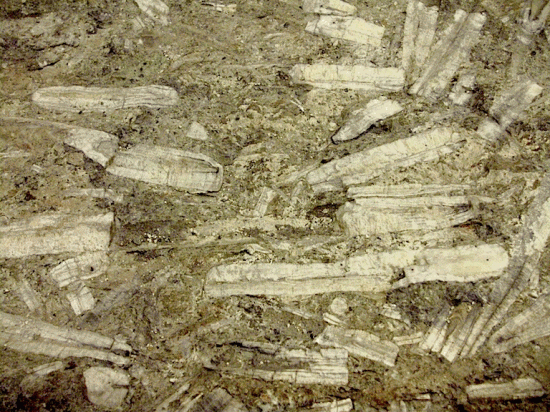
‘Thunderstones’ in the form of fossil belemnites (Belemnitida), Courtesy Pacific Museum of the Earth, Vancouver, Canada. © ‘Timmy’ alias ‘The High Fin Sperm Whale’ (2009).
Original Post August 27, 2012
That many a thunderstone earned the sobriquet by virtue of its exposure during a thunderstorm strikes one as correct to a degree.
Intellectual lassitude perfuses the attempts of those who blamed the conception of the thunderstone on sheer stupidity or, one notch up, a rebarbative belief that ‘stones were carried up into the clouds by water spouts and then redeposited during thunderstorms’; meteorites would have been among such ‘terrestrial rocks that had been struck by lightning’. This line of argument makes a mockery of the universal belief in the reality of the thunderstone insofar as it invokes purely imaginary scenarios.
Somewhat more penetrating was Eliade’s beady observation that the thunderstone logically connects with the common ancient perception of the entire sky as a solid ‘firmament’: ‘The same conception of a solid celestial vault explains the virtues of meteorites and thunderstones’. However, the archetype of the ‘solid sky’, though real, presents an even greater mystery than the thunderstone itself.
The American geomythologist Adrienne Mayor argued the case for fossils: ‘The lightning motif reflects the natural fact that violent thunderstorms expose big fossils to view, but it also reflects the attempt to imagine a force powerful enough to destroy monsters of such size and strength’. ‘… a severe thunderstorm would wash away soil, revealing fossils that were not visible before: hence the common association of fossils with Thunder Beings’.
Direct accounts confirm that fossils were often revealed in the aftermath of storms. An Oglala informant volunteered the memory of the discovery of a fossil proboscidean:
‘A Lakota hunting party traveled down by where Colorado Springs is now. … These hunters camped in a high meadow one night, and there was a strong storm with thunder and lightning striking over and over below on the plain. Why was the Thunder so violent there, they wondered, what were the Thunder Birds trying to kill there? In the morning, they said, Let’s go see why the Thunder Birds were so angry. They went down to the lower elevation where the lightning had been striking. They found a very large animal carcass like nothing they knew. They had never seen an animal like that. It was really big, and it had a strange, big, or maybe a long nose – so strange that they wondered how it managed to eat’.
Fossils aside, the thunderstone as a peculiar rock or prehistoric tool would often surface after thunderstorms as well. On the authority of Pliny, ‘the Magi … hunt for it zealously because it is found only in a place that has been struck by a thunderbolt’. From Sark, one of the Channel Islands, comes the story in which ‘A cow is killed by lightning in the field, the peasant digs up the earth round it and finds the thunderstone, a small green stone axe’. Mongol shamans claimed to retrieve Buumal, ‘a kind of tool or weapon used by people during the Bronze Age’, from ‘places where the lightning had struck’. Zulu shamans asserted that ‘where the lightning strikes the ground, … there is something resembling the shank of an assagai, which remains in the earth, and this thing is called a thunderbolt; they dig till they find it …’ And the Skidí Pawnee (Nebraska) told that the first man, Piruski (‘Closed-Child’), ‘went to the place where the Lightning had struck upon the mountains’: ‘He found flintstones with bows and arrows, and even good-sized pieces of axes, so that he now made bow and arrows’.
Was the common discovery of prehistoric tools at places where the lightning struck perhaps not coincidental, but statistically likely as the tools positively attracted the lightning? The Mongolian researcher Pu̇rėv Otgony pondered the question seeing that the Buumal were ‘ancient copper-alloy artefacts that were concealed by the earth’: ‘They were rediscovered or unearthed many years later when they were struck by lightning as a result of their high electrical conductivity’.
Yet the theory that fossils or prehistoric tools owed ‘thunderstone’ status to the tempests that often exposed them cannot stand on its own. After all, why single out the thunderbolt when storms equally feature rain, wind, clouds and darkness? The likes of ‘rainstones’ or ‘windstones’ are hardly heard of in the pages of myth.
In the case of sea-urchins, the star-like anatomy may have suggested an astral origin, though astral does not equate to tempestual. A contributing factor of which Mayor was well aware was the cross-cultural tradition that fossils were mythical entities whose remains the lightning not only weathered out, but also formed long before their discovery. In the global mythology of creation, lightning often serves as a petrifying or ossifying agent operating at a time of cosmic upheaval. Whereas signs of burning or scorching on fossils may have reinforced such beliefs, some sort of actual environmental disaster must have provoked the stories in the first place.
Rens Van Der Sluijs
Books by Rens Van Der Sluijs:
On the Origin of Myths in Catastrophic Experience, vol. 2: The Earth’s Aurora












